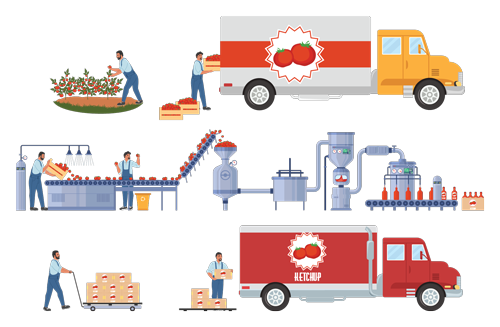What is SKU Rationalization?
Built For

Have you ever walked into a storage room, looked at the overflowing shelves, and thought, “Do we really need all this?” Businesses face a similar dilemma with their inventory all the time, leading us to our article’s topic today: SKU Rationalization — a strategy as essential to inventory management as a lighthouse is to ships at sea. But what exactly is it?
SKU Rationalization is like a strategic game of “Keep or Toss” played by companies to ensure they’re not drowning in a sea of products — keeping only the items that sell well, make good money, or hold strategic value. It’s about finding that” Goldilocks Zone” of inventory: not too much, not too little, but just right.
In today’s blog, we’re diving into the nitty-gritty of SKU Rationalization. We’ll explore why businesses must get smart about the SKUs (stock-keeping units) they stock. From reducing costs to skyrocketing efficiency, this process ensures that every product on your shelf is there for a good reason.
So, whether you’re a small business owner, an inventory manager, or just curious about the inner workings of product management, join us on a journey through SKU Rationalization, where each step can lead to more streamlined operations and, ultimately, a better bottom line.
SKUs: The Building Blocks of Inventory Management
In the alphabet soup of sales and inventory management, “SKU” is a term that frequently pops up. But what does it stand for? SKU is shorthand for Stock Keeping Unit, and it’s essentially a unique code that identifies each product in a company’s inventory. Think of it as a personal ID for products that tells you everything from the brand to the size, color, or any other attribute.
Why are SKUs important?
SKUs play a critical role in the world of inventory. SKUs make it easy to track and manage products from when they arrive at a warehouse to when they are shipped. Here’s what makes SKUs indispensable:

- Tracking: With SKUs, businesses follow the journey of a product throughout its lifecycle in the inventory system.
- Sales analysis: SKUs provide valuable data points. By analyzing SKU-level sales data, businesses make informed decisions about which products to promote, discount, or discontinue.
- Inventory control: Goodbye, guesswork! SKUs help manage stock levels effectively, reducing the likelihood of understocking or overstocking.
SKUs vs. UPCs: A quick primer
While we’re on the topic, let’s clear up a common confusion: the difference between SKUs and UPCs (Universal Product Codes). UPCs are standardized barcodes used universally, while SKUs are unique to each business. UPCs are like passports, the same wherever you go, while SKUs are more like nicknames that vary from place to place.
The Necessity of SKU Rationalization
It’s a common misconception that more choice equals more satisfaction. In inventory management, too much choice can lead to complexity, inefficiency, and wasted resources. That’s where SKU rationalization steps in, emphasizing that sometimes, less is indeed more.
Why can’t we stock everything?
Stocking every conceivable product variant may seem like a customer-centric approach, but it often leads to inventory bloat – a situation where a significant portion of stock rarely sells or turns into dead stock. Here’s why that’s a problem:
- Overstocking ties up capital that could be used elsewhere in the business. It leads to increased storage costs and can result in product obsolescence. Overly diverse inventory can confuse customers and dilute sales among too many options.
- Inventory carrying costs include storage, insurance, taxes, and more. These can eat into a company’s profits if not managed well.
- Complexity of demand. Consumer demand is often unpredictable and varies significantly from one SKU to another. Some products may only sell seasonally or have sporadic demand, complicating inventory planning.
- The opportunity cost of missed sales. It’s not just about what you have in stock; it’s also about what you’re missing. Too many slow-moving SKUs prevent a business from investing in products that could sell better or have higher profit margins. It’s essential to strike a balance between variety and demand.
SKU rationalization: A strategic imperative
Businesses can significantly reduce complexity and cost by periodically reviewing and rationalizing SKUs. This process helps in:
- Focusing on high-performing products.
- Allocating resources to SKUs that are more likely to drive growth.
- Streamlining operations to improve customer experience with the right product mix.
In a world where consumer preferences shift rapidly, staying nimble with a well-rationalized SKU portfolio isn’t just smart; it’s a strategic imperative for survival and growth.
Making Every Product Count with SKU Rationalization
SKU rationalization is not about haphazardly slashing products from your inventory. It’s a deliberate process that involves data, strategy, and sometimes a little bit of intuition. Here’s how businesses can turn SKU rationalization into a systematic exercise that yields results.
Step 1: Gather the data
The first step in SKU rationalization is all about getting your facts straight. Compile data on all your SKUs, covering sales volume, profitability, turnover rates, and other relevant metrics. This data forms the backbone of your rationalization efforts.
Step 2: Analyze performance
With data in hand, it’s time to play detective. Look for trends, patterns, and outliers. Which products are the bestsellers? Which ones are barely breaking even? This isn’t just about numbers; consider factors like seasonal trends or marketing efforts that could affect performance.
Step 3: Categorize your SKUs

Create categories for your SKUs based on their performance. A standard method is the ABC analysis:
- A-items: High-value products with a significant contribution to overall profit.
- B-items: Mid-range products with moderate sales and profitability.
- C-items: Low-value products that are infrequently sold or have low margins.
Step 4: Make decisions
Now comes the tricky part — deciding which SKUs to keep, modify, or discontinue. This decision should be based on a combination of quantitative data and qualitative factors, such as brand image, market trends, and customer loyalty.
Step 5: Implement changes
After the decisions are made, implement changes methodically. This might involve phasing out products, adjusting purchasing strategies, or renegotiating with suppliers. Communication is critical here; ensure all relevant departments are in sync with the new strategy.
Step 6: Monitor and adjust
SKU rationalization isn’t a one-and-done task. It’s an ongoing process that requires ongoing review and adjustment as market conditions change. Keep an eye on how the changes affect your business, and be ready to pivot as needed.
The more SKUs your business has employed directly correlates to the task size. However, the SKU rationalization process can be significantly simplified, provided your business has the inventory management tools needed to make data-driven decisions and execute a successful SKU rationalization strategy.
Leveraging Inventory Management Software in SKU Rationalization
Inventory management software has become a linchpin for businesses aiming to streamline their SKU rationalization process. Inventory management software offers tools to transform a mountain of data into actionable insights.
Automated data collection and analysis
Inventory management software automatically tracks and analyzes purchases, sales orders, returns, and stock levels across all SKUs in real time, providing a comprehensive and up-to-date picture of inventory performance and eliminating the guesswork and manual errors associated with traditional methods.
Predictive analytics and forecasting
Inventory management software employs predictive analytics to forecast demand and sales trends. By predicting future performance, businesses can make informed decisions on which SKUs to prioritize, which to phase out, and where there may be opportunities for new products.
Centralized information hub
A centralized hub for all inventory-related information is crucial when multiple departments are involved in the SKU rationalization process. A single source of truth ensures everyone from finance to procurement to sales to warehouse management is on the same page.
Efficient inventory optimization

Inventory management software includes optimization features that suggest ideal stock levels based on historical sales data and trends, helping businesses maintain optimal inventory levels and minimize excess stock and the associated carrying costs.
Customizable reporting
Custom reports can be generated to focus on specific aspects of SKU performance. This tailored approach ensures that stakeholders have access to the information most relevant to their needs and can track the progress of the rationalization process.
Continuous improvement
Finally, inventory management software facilitates a cycle of continuous improvement. As businesses evolve, the software can adapt, providing ongoing support for SKU rationalization efforts and ensuring that inventory management remains agile and responsive to market demands.
Reaping the Rewards of SKU Rationalization
After navigating the SKU rationalization process, businesses can look forward to reaping various benefits. These rewards bolster the bottom line and create a more agile and customer-focused operation. The benefits of SKU rationalization include:
Enhanced inventory turnover
By shedding underperforming SKUs, companies reduce the number of days inventory sits on shelves. Faster turnover means more sales without additional inventory investment, leading to a healthier cash flow and reduced risk of obsolescence.
Supply chain efficiency
A streamlined SKU list simplifies everything from ordering and stocking to picking and shipping, leading to cost savings and reduced labor.
Reduced warehousing costs
Less variety in the warehouse equates to less space needed to store goods, significantly lowering warehousing costs, including rent, utilities, and insurance.
Better alignment with customer demand
SKU rationalization ensures that a company’s product offering matches customers’ wants. This alignment improves customer satisfaction and loyalty and reduces the frustration of choice overload.
Increased sales focus
With fewer SKUs, marketing and sales efforts can be more focused and effective. Creating targeted promotions and sales strategies is easier when you’re not trying to push a vast array of products.
Operational simplicity

Fewer SKUs simplify operations, leading to fewer errors, reduced training time for new employees, and an overall more manageable business model.
Data-driven decision making
SKU rationalization fosters a culture of data-driven decision-making. With clear insights into what sells and what doesn’t, companies make more intelligent choices about product selection or development and inventory investment.
Competitive advantage
A well-rationalized SKU portfolio gives companies a competitive edge. Businesses differentiate themselves by focusing on what they do best and what their customers truly value.
SKU Rationalization: A Strategy for Sustainability
SKU rationalization is more than just a cost-cutting exercise; it’s a strategy for building a sustainable and resilient business. In an ever-changing business landscape, the ability to adapt and streamline offerings is not just advantageous—it’s essential. By regularly evaluating and adjusting their SKU strategy, businesses can stay relevant, responsive, and ready to meet the future head-on.
Frequently Asked Questions about SKU Rationalization
What is SKU rationalization?
SKU rationalization is the process of analyzing a company’s stock-keeping units (SKUs) to determine which items should be kept, discontinued, or modified. SKU rationalization aims to optimize inventory by focusing on products that sell well and contribute positively to the company’s bottom line.
Why is SKU rationalization important?
SKU rationalization helps businesses avoid the pitfalls of overstocking and understocking, reduces warehousing costs, improves supply chain efficiency, and ensures the product is aligned with customer demand.
How often should a business perform SKU rationalization?
The frequency of SKU rationalization can vary depending on the business size, industry, and market dynamics. However, it’s generally recommended to perform SKU rationalization at least once a year or whenever there’s a significant change in market trends or business objectives.
Can SKU rationalization lead to a loss in sales?
If not done carefully, SKU rationalization could lead to a loss in sales, especially if popular products are incorrectly discontinued. Using accurate data and considering customer preferences and trends during the SKU rationalization process is essential.
What data is needed for SKU rationalization?
Businesses should gather data on sales volume, turnover rates, profitability, customer buying patterns, seasonal trends, and other metrics relevant to their products and market.
How does inventory management software help with SKU rationalization?
Inventory management software automates data collection, provides predictive analytics, centralizes information, and helps develop different rationalization scenarios, making the process more efficient and data-driven.
Call us at 817-870-1311




